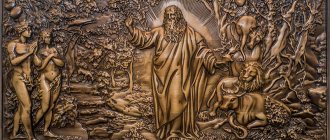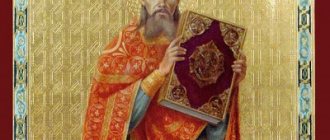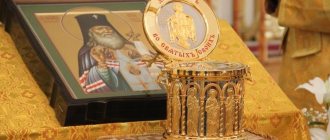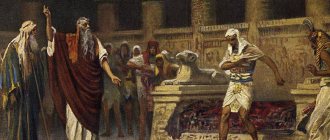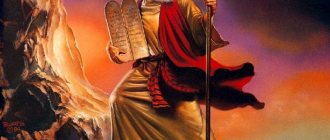Why is the Lord Jesus Christ called the Messiah?
In the times of the Old Testament, anointing with a special substance - consecrated oil or myrrh - was accompanied by the initiation of a person into three types of social activities. This action was approved by God himself. It was believed that when performing the rite of anointing, God's blessings and the gifts of the Holy Spirit were brought down on a person. For this reason, the role of the anointed was placed in connection with serving God.
Man has known since ancient times about the Coming of the Great Righteous One, Who will deliver people from corruption and death, the power of the devil and sin. This Righteous One was repeatedly designated in the Holy Scriptures either as a Priest (Ps. 109:4), or as a Prophet (Deut. 18:15), or as a King (Ps. 45:2). At the same time, He was reported as God (Ps. 109: 1–2), Who, without ceasing to be the Lord of heaven and earth, would take human nature into His Eternal Hypostasis and be born as Man (Mic. 5: 2–3) . And it is as a Man that He will receive the fullness of the gifts of the Holy Spirit (Is. 11:2). All these prophecies were, of course, about the Lord Jesus Christ).
That is why He was called the Messiah or, which is the same thing, the Anointed One: “The Spirit of the Lord God is upon Me, for the Lord has anointed Me...” (Is.61:1). True, what was meant there was not the rite of anointing the Savior with the sanctified ointment: it was understood that the Spirit would rest on the Messiah, as on a Man, due to special grace, and rest in fullness, as far as possible for human nature (Ps. 45:8-9 ). Later the apostle would note that “in Him dwells all the fullness of the Godhead bodily” (Col. 2:9).
Who is the Messiah in the Bible?
Estimated reading time: less than a minute.
King David and Solomon, the Pharisees and Caesar, the prophet Elijah and many other such familiar and, at the same time, unfamiliar names. Who were all these biblical heroes? How well do we know who is who in the Bible? Are we sometimes confused with some mythological characters? To understand all this, “Thomas” opened a project of short stories “Biblical Characters”. Today we are talking about who the Messiah is in the Bible.
When talking about the Holy Scriptures and the history of the Jewish and Christian religions, two different words can be confused. “Mission” (from the Latin “missio” - departure, sending) - the meaning of existence or activity, “Messiah” (from the Hebrew “Mashiach” - “anointed one”) - has an allegorical meaning of “king” and is one of the key concepts in the Bible . It is translated into Greek as "Christ"
Prophecies
One of the greatest dichotomies we find in Scripture is in one common supernatural phenomenon in prophecy: He will be a man, and yet He will be God. Look what three different prophets predicted:
“And you, Bethlehem Ephrathah, are you small among the thousands of Judah? from you will come to me one who is to be ruler in Israel and whose origin is from the beginning, from the days of eternity.” (Mic. 5:2)
“Therefore the Lord Himself will give you a sign: behold, a virgin will be with child and give birth to a Son, and they will call His name Immanuel.” (Isa. 7:4)
“For unto us a child is born, unto us a son is given; the government will be upon His shoulder, and His name will be called Wonderful, Counselor, Mighty God, Everlasting Father, Prince of Peace.” (Isa. 9:6)
“Behold, the days are coming, says the Lord, that I will raise up a righteous Branch for David, and a King will reign, and will act wisely, and will execute judgment and righteousness in the earth. In His days Judah will be saved and Israel will live in safety; and this is His name by which they will call Him: 'The Lord is our justification!'” (Jer. 23:5-6)
MESSIAH
MESSIAH [Greek] μεσσίας, from Aramaic משיהא (mshiha), Heb. משיה (mashiach), lit. – anointed; Greek semantic equivalent - χριστός], in religion - a savior sent by God who must establish his kingdom forever.
In the Ancient East, the ritual of anointing with oil was widespread, including as part of the ritual of enthroning a king. In the Tanakh the term "M." (“Mashiach”) denotes a person chosen by God (“the Lord’s anointed” - 1 Samuel 24:7) and invested with special power through ritual anointing with oil (olive oil). M. was first of all called the king, who was entrusted with the responsibility of caring for the people (2 Kings 2:4; 1 Kings 1:39; in Is. 45:1 M. is named the Persian king Cyrus), sometimes a priest (or only the high priest ) (Ex. 40:13–15; Lev. 8:12) and possibly a prophet (1 Kings 19:16). Starting from the period of the Babylonian captivity (6th century BC), in connection with the death of the Kingdom of Judah, Jews began to have an idea of the future ideal ruler from the family of King David, whose reign would put an end to wars and strife throughout the entire earth, marking the beginning of a new era of peace and prosperity (Isa. 11; Mic. 5:1–5; Hos. 3:5, etc.), as well as the idea of two simultaneously coming anointed deliverers—a priest and a ruler (Zech. 3–4). In the minds of the Jews people, these prophecies were most likely associated with real historical events. personalities (for example, with the high priest Joshua, the son of Jozedek, King Hezekiah or Zerubbabel). During the period of the Second Temple, in conditions when the hope for the Jews to gain independence and restore the rule of the Davidic dynasty became increasingly illusory, the doctrine of the anointed one, united with the teaching of the prophets about the coming deliverance, began to acquire an eschatological quality. direction, according to which the idea of M.’s arrival was established not in history. time, but “at the end of times.” The idea of M. as the savior of the Jews. people especially manifested themselves during the period when the Jews were under the rule of the Seleucids and then the Romans. This is reflected in many apocryphal stories. Jewish texts, in the New Testament and apocryphal. early Christian texts created between 250 BC. e. and 100 n. e. (Psalms of Solomon 17; 18:6; Books of Sibyls 3:652–656; Testament of Judah 22, 24; Testament of Levi 18; 1 Enoch 37–71; 4 Ezra 7, 11–12, 13; Luke 3:15– 17; 17:20). The large differences in M.'s descriptions in these texts indicate that generally accepted ideas about his origin, role and fate did not exist at that time. In the so-called created at the same time. In the Dead Sea texts (see Qumran Studies) there is an idea of M. the king, of two M. - a king and a priest, of M. - the son of God, etc. In the writings of Josephus and the Acts of the Apostles, mention is made of the appearance at the turn of the new era of a series contenders for the role of M.: Theudas, Judas the Galilean, Simon, Afrongeus.
Faith in Jesus of Nazareth as the true Messiah-Christ proclaimed in the Holy Scriptures (John 1:41; 4:25) (see Jesus Christ) determined the emergence of Christianity (1st century AD) and the demarcation between Christianity and Judaism . In Christianity, Jesus is considered a descendant of King David, and the messianic terminology of Jewish sacred texts is associated with Him: “King of the Jews,” “Lord,” “Son of Man.” Moreover, Jesus Christ is not just a man, but a God-man. His coming is not interpreted as deliverance from politics. or social oppression, but as the salvation of all people who believed in Him from slavery to sin, from death and the acquisition of eternal life in God. In Christianity, doctrines about the Antichrist and the Second Coming of Christ at the end of times were formed to judge people and the final establishment of His Kingdom (see also the Last Judgment, Christology, Kingdom of God, Eschatology).
For the Jews, the idea of M. acquired particular relevance in connection with the liquidation of the Hebrews by the Romans. statehood, the destruction of the Second Temple (see Temple of Jerusalem) and the expulsion of the Jews. people from the Land of Israel (1st century). The Jews should bring deliverance from disasters and persecution. to the people of M., who in rabbinic. Judaism is understood as historical. personality, his coming presupposes the onset of the “golden age”, the resurrection of the dead, the appearance of the “heavenly Jerusalem” and the miraculous transfer to it of all the Jews scattered throughout the world. Over the centuries and to this day, these aspirations have contributed to the fact that M. declared the leaders of various. movements in Judaism and Heb. political movements. So, in the 2nd century. some rabbis, including Akiva, recognized M. as the leader of the Jews. Bar Kokhbu uprising. It is possible that the defeat of Bar Kochba became the stimulus for the formation of the doctrine of the suffering M. - the pre-messiah, a descendant of Joseph, whose death will anticipate the coming of M. the king from the line of David. An idea arose about the suffering that the world must endure before the coming of M. The Mishnah mentions the “days of the Moshiach,” and in the Gemara there are descriptions of the signs of the coming of M., discussions about his name and place of birth. In the Middle Ages, on the one hand, many apocalyptic stories appeared. midrashim (“Book of Zerubbabel”, “Signs of the Messiah”) as a result of disasters that befell Jews in different countries (in particular, an aggravation of apocalyptic sentiments was observed in connection with the spread of Islam). On the other hand, the attitude towards the expectation of M. became more rationalistic in Judaism: the idea of the messianic era as a political era was substantiated. independence and enlightenment (works of G. Saadia, M. Maimonides, “Book of Beliefs and Opinions”). By including the idea of M. in the list of obligations. principles of faith, Maimonides warned against expecting signs, miracles and the transformation of the world associated with the arrival of M. The idea of M. underwent some rethinking in Kabbalah. According to Kabbalistic teachings of I. Luria (17th century), a person of his own. efforts through prayers and certain mystical religions. action may bring the coming of M. This teaching had a strong influence on the later messianic movements that arose among Muslim Jews. countries, in particular on Sabbatianism (see Sabbatai, Dönme), which combined the Lurian idea of M. correcting the world and the Christian idea of atonement, of M. taking upon himself the sins of the world, destroying evil from within. Sabbatianism became the basis of the teachings of the messianic sect of J. Frank. According to the teachings of Hasidism, in which Ch. attention is focused not on the salvation of the world, but on the salvation of man, personal, internal liberation, M. can become a tzaddik, saving his generation by the power of his righteousness, and the righteous generation can be worthy of the arrival of M. In the 20th century. Messianic teaching developed within the Chabad movement. In the beginning. 21st century In the Jewish teaching about M., eschatological practically disappeared. component, predictions about the imminent arrival of M. are of a marginal nature. The most relevant form of this teaching is the so-called formulated within the framework of Zionism. political messianism, main the idea of which is that the creation of the State of Israel was the beginning of the messianic era without the Messiah.
The concepts of M., messianism (messianicism) are close to the concepts in Islam - Mahdi, in Zoroastrianism - Saoshyant, in Buddhism - Maitreya. Ideas about future deliverance are inherent in some politicians. exercises.
Appearances of the False Messiah throughout the 20th century
In history, there are many known phenomena of the False Messiah, carried out by people in order to enrich themselves or gain fame and influence. It is worth noting that often high hopes were associated with these people. Christ himself repeatedly warned his followers about the appearance of False Messiahs.
In modern psychiatry there is also a definition of “Jerusalem syndrome”, or “messianic syndrome”, applicable to mentally ill people who consider themselves prophets of the gods and teachers of humanity.
Among the most famous False Messiahs of the 20th century, Grigory Grabovoi, the scandal with whose participation thundered in the case of “resurrection of the children of Beslan”, especially stands out; Jim Jones, founder of the Peoples Temple Church and instigator of the massacre of its adherents in 1978; Sun Myung Moon, founder of the South Korean sect “Unification Church”; Marina Tsvigun, who called herself the Virgin Mary Christ, created a sect named after herself in 1980 and declared herself “the Messiah of the Age of Aquarius and the Mother of the World.”
Criteria for the coming of the Messiah in the Old Testament (Tanakh)
The concept of the coming of the Messiah was introduced by the prophets of ancient Israel. Thus, if a person declares himself (or someone declares him) to be the Messiah, then one should check whether he has done what the Hebrew prophets expect from the Messiah.
From the point of view of Judaism, in the Old Testament (Tanakh), the main criterion for the coming of the Messiah is the prophecy of Isaiah, which indicates that the days of the coming of Moshiach will be an era of interethnic and social changes:
“And all the nations will beat their swords into plowshares (that is, ploughs), and their spears into pruning hooks; nation will not lift up sword against nation, and they will no longer learn to fight.” (Isa.2:4)
Thus, according to biblical prophecies, during the time of Moshiach, wars will cease, universal peace and prosperity will come, and all people, enjoying peace and harmony, will be able to devote themselves to the knowledge of God and spiritual improvement.
Savior of humanity
And yet, some interpreters of the Holy Scriptures have tried to explain what the highest purpose of creation is. It turns out that it consists in establishing the Kingdom of Heaven on earth. The Fall disrupted the plans of the Creator, after which hell reigned on earth. The coming of the coming Savior was precisely supposed to restore the previous state of affairs and create the Kingdom of God instead of earthly hell.
It is assumed that the one who will be sent to earth for the purpose of saving humanity is not able to indulge in sin, but must be in complete harmony with the Divine nature. The Deliverer must be a perfect being, like the Creator himself. He could not have been born in sin, and the earthly life of the messiah must be a model of righteousness.
In the Christian religion, it is believed that the coming of the Messiah is divided into two stages. The Savior first appeared on earth in the form of Jesus Christ two thousand years ago. In the distant future, the timing of which cannot be precisely determined, the second coming is inevitably expected. This time, Christians are convinced, Jesus will finally establish the Kingdom of Heaven on earth.
Buddhism teacher
In Buddhism there is also a concept similar to the Christian and Judaic Messiah and having the features of a cyclical sojourn in the mortal world.
Strictly speaking, according to Buddhist religious tenets, there are countless numbers of Buddhas as beings who have comprehended the truth, and each of their appearances on the planet is nothing more than a link in the endless chain of the universe. Thus, every Buddha is an intermediary in achieving world knowledge between people and God. Close to the concept of Buddha in character, but alien in function, is the Bodhisattva - “a being striving for awakening” and who has decided to take on the role of a Teacher in the process of people achieving universal truth. The motivation for this action is considered to be the bodhisattva’s desire to save all living beings from suffering and liberate them from samsara - the endless circle of rebirths.
Therefore, the Buddhist Messiah is Bohisattva Maitreya, whose prophetic appearance at the end of Satya Yuga is recognized by all schools of Buddhism. His name literally means "Lord Called Compassion." He is the future Teacher of humanity, will give the New Teaching and will himself be the bearer of the Buddha’s Teaching. People will break the network of passions, learn to enter a trance and lead a chaste and righteous life.
One of the phenomena that heralds the coming of Maitreya will be a reduction in the area of the oceans so that the Bodhisattva can easily cross them.



